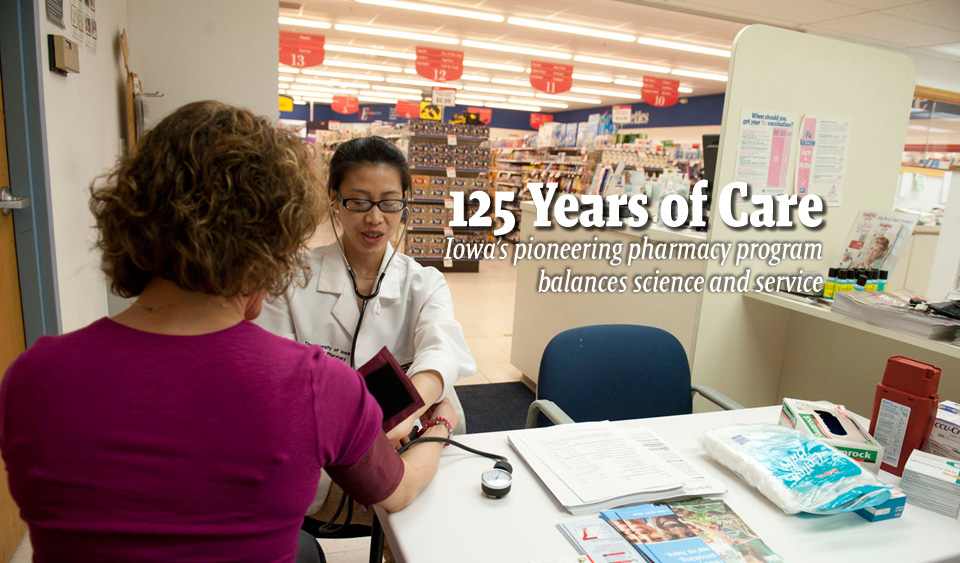-
Page Navigation Links:
- Skip to Site Navigation Links
- Skip to Features

- The University of Iowa
- Spectator
- Monthly News for UI Alumni and Friends
Pharmacy student Hillary Charmichael is on a five-week rotation at University of Iowa Hospitals and Clinics, monitoring patients who are taking the drug warfarin to prevent blood clots. The drug interacts with many other medications and certain foods, so she and colleagues play a critical role.
“We build relationships with patients’ doctors and work with them on dosage adjustments,” says Charmichael, who graduates in May. “We’re also responsible for teaching patients about the drug and its effects.”
Charmichael’s previous rotations include a stint studying pharmacy law, an advanced management experience with Walgreens, and even field work in Belize—in short, the multifaceted education that’s typical for today’s UI pharmacy students.
Pharmacy education and practice have changed radically since 1885, when the first UI pharmacy program was founded. Iowa’s program has been quick to embrace scientific discovery, shifts in the pharmaceutical industry, and new ideas about pharmacists’ role in health care.
“Iowa was at the forefront of many of these movements, responding like few other schools,” says Donald Letendre, dean of the UI College of Pharmacy. As they celebrate their program’s 125th anniversary, he and colleagues are also shaping what’s next for the profession.
Home remedies
Late 19th century pharmacy training was scattershot. Outside a few private education programs, most pharmacists learned the craft through apprenticeships. Methods and medications varied widely.
“This was the era of home remedies and drugs made entirely from natural products,” says Letendre, noting that plant-based components remain part of many modern medications. “A cadre of pharmacists wanted to inject more science into the field.”
The drive for scientific and professional rigor prompted state licensure programs. Iowa’s 1880 pharmacy law set standards for selling medicines and established separate roles for physicians (prescribing) and pharmacists (preparing and dispensing).
Pharmacy programs at public universities soon followed, most mandating two or three years of formal education. Iowa’s became only the fourth such program based at a state school.
Soul searching
Scientific, industrial, and social changes propelled pharmacy’s evolution through the 20th century. Degree programs kept pace, expanding to four, then five, years.
Iowa’s pharmacy program emerged as a pioneer. In 1938, the University established the first graduate program in hospital pharmacy. In the early 1960s, it introduced the Unit Dose System, which became a national model for centralized drug distribution in hospitals.
By the sixties, chemistry and manufacturing advances had revolutionized pharmaceutical development, and pharmacists found themselves largely distributing mass-produced drugs rather than formulating compounds behind the counter. The shift prompted some soul-searching for the profession.
“Early in my education, I remember being told not to discuss a drug or disease with a patient—that was the doctor’s job,” Letendre says. “But pharmacists soon realized we could and should do more.”
The resulting emphasis on direct patient care drives contemporary pharmacy education, especially at Iowa. Students frequently learn alongside peers from medicine and other fields, and practicing pharmacists commonly collaborate with fellow health professionals in hospitals, clinics, and communities.
“Pharmacists bring a world of knowledge that complements physicians’ knowledge,” Letendre says. “Our clinical practitioners and faculty are making collaborative practice the norm, and creating new models for other schools to follow.
Beyond the old-time drugstore
Today’s Iowa students take on a rigorous training program much like medical or dental students, earning a doctor of pharmacy—or PharmD—degree that prepares them for practice in a host of settings. Many continue to work in pharmacies, but the proliferation of pharmacy chains has changed that practice, too.
“Our state is actually one of the last great bastions of independent pharmacies, with more than 200 across Iowa,” Letendre says. “They’re essential to the fabric of their communities—in some towns, the pharmacist may be the only primary care professional.”
Other grads have found opportunities throughout the pharmaceutical industry, in drug discovery, research, marketing, and management roles that once might have been held by physicians. This expansion has drawn students who may not have considered pharmacy in the past, including many more women.
Iowa’s College of Pharmacy has launched a sweeping overhaul of its curriculum, looking to new methods and technologies that stress teacher-student dialogue, hands-on practice, and self-directed learning. The goal: an even more adaptable and future-proof pool of graduates.
A 1950s-era building is hardly suited for a 21st century curriculum, so Letendre and colleagues are setting targets for facilities improvements, too. They also want to draw on the perspective and experience of alumni.
As part of its anniversary year, the college inaugurated the 1885 Society, an organization designed to foster alumni connections. Alumni also joined last fall’s White Coat Ceremony to officially induct the first-year pharmacy class.
The 19th-century apprentice system is long gone, but mentoring relationships between students and practitioners have never been more important, Letendre says.
“Our alumni reflect what our college is all about,” he adds. “In their example, students see everything that’s possible.”
—Lin Larson
photo by Kirk Murray
© The University of Iowa 2009
